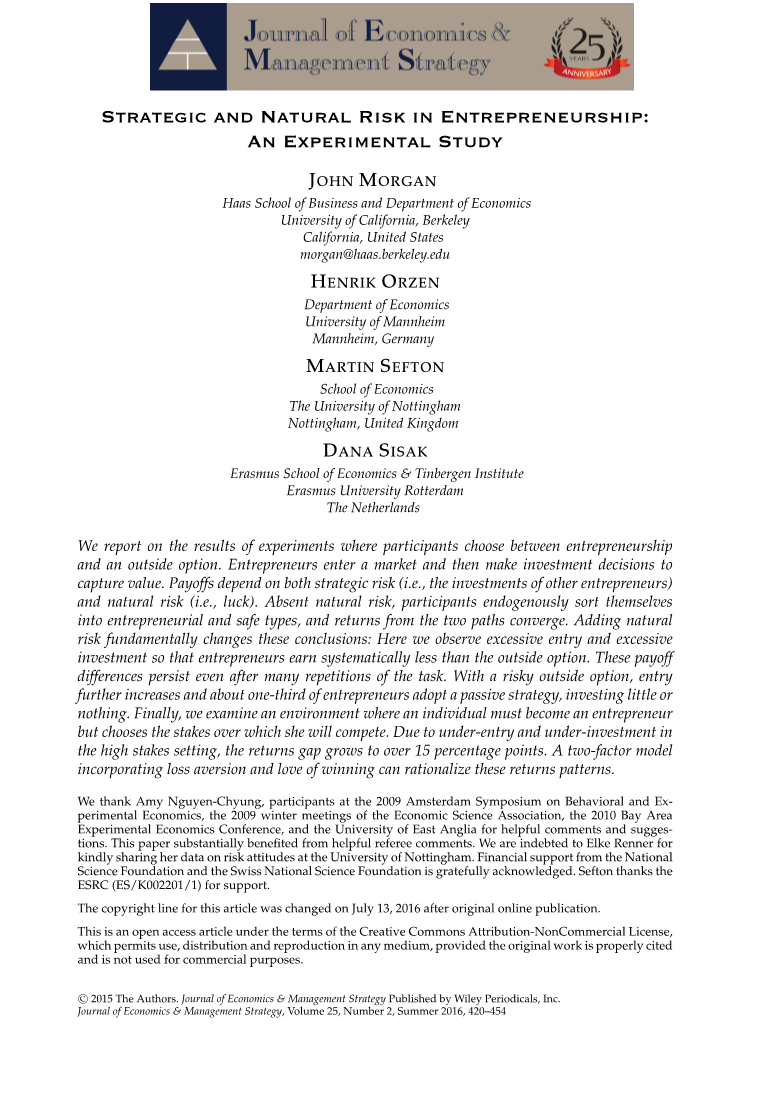

英语原文共 35 页,剩余内容已隐藏,支付完成后下载完整资料
Strategic and Natural Risk in Entrepreneurship: An Experimental Study
创业战略风险与自然风险:实验研究
JOHN MORGAN
约翰摩根
Haas School of Business and Department of Economics
University of California, Berkeley
California, United States morgan@haas.berkeley.edu
哈斯商学院和经济系
加州大学伯克利分校
加利福尼亚州,美国morgan@haas.berkeley.edu
HENRIK ORZEN
Department of Economics
University of Mannheim Mannheim, Germany
经济系
曼海姆大学曼海姆
德国
MARTIN SEFTON
School of Economics
The University of Nottingham Nottingham, United Kingdom
经济学院
诺丁汉大学,英国诺丁汉大学
DANA SISAK
Erasmus School of Economics amp; Tinbergen Institute
Erasmus University Rotterdam
The Netherlands
伊拉斯姆斯经济学院和丁伯根学院
伊拉斯姆斯大学鹿特丹
荷兰人
We report on the results of experiments where participants choose between entrepreneurship and an outside option. Entrepreneurs enter a market and then make investment decisions to capture value. Payoffs depend on both strategic risk (i.e., the investments of other entrepreneurs) and natural risk (i.e., luck). Absent natural risk, participants endogenously sort themselves into entrepreneurial and safe types, and returns from the two paths converge. Adding natural risk fundamentally changes these conclusions: Here we observe excessive entry and excessive investment so that entrepreneurs earn systematically less than the outside option. These payoff differences persist even after many repetitions of the task. With a risky outside option, entry further increases and about one-third of entrepreneurs adopt a passive strategy, investing little or nothing. Finally, we examine an environment where an individual must become an entrepreneur but chooses the stakes over which she will compete. Due to under-entry and under-investment in the high stakes setting, the returns gap grows to over 15 percentage points. A two-factor model incorporating loss aversion and love of winning can rationalize these returns patterns.
我们报告了参与者在创业和外部选择之间进行选择的实验结果。企业家进入市场,然后做出投资决策以获取价值。收益取决于战略风险(即其他企业家的投资)和自然风险(即运气)。缺乏自然风险,参与者内生地将自己分类为创业型和安全型,两条路径的收益汇合。增加自然风险从根本上改变了这些结论:在这里,我们观察到过度进入和过度投资,使企业家系统地获得比外部选择更少的收入。即使经过多次重复的任务,这些收益差异依然存在。外部风险较高时,进入进一步增加,约三分之一的企业家采取被动策略,投资很少或没有投资。最后,我们研究了一个环境,一个人必须成为企业家,但选择她将参与竞争的风险。由于高利润条件下的投资不足和投资不足,回报差距增长超过15个百分点。包含损失厌恶和获胜之爱的双因素模型可以合理化这些回报模式。
We thank Amy Nguyen-Chyung, participants at the 2009 Amsterdam Symposium on Behavioral and Experimental Economics, the 2009 winter meetings of the Economic Science Association, the 2010 Bay Area Experimental Economics Conference, and the University of East Anglia for helpful comments and suggestions. This paper substantially benefited from helpful referee comments. We are indebted to Elke Renner for kindly sharing her data on risk attitudes at the University of Nottingham. Financial support from the National Science Foundation and the Swiss National Science Foundation is gratefully acknowledged. Sefton thanks the ESRC (ES/K002201/1) for support.
我们感谢2009年阿姆斯特丹行为与实验经济学研讨会的参加者,2009年经济科学协会冬季会议,2010年海湾地区实验经济学会议和东安格利亚大学的参与者Amy Nguyen-Chyung提供了有用的意见和建议。本文充分受益于有用的裁判评论。我们感谢埃尔克雷纳亲切分享她在诺丁汉大学的风险态度数据。感谢国家科学基金会和瑞士国家科学基金会的财政支持。 Sefton感谢ESRC(ES / K002201 / 1)的支持。
The copyright line for this article was changed on July 13, 2016 after original online publication.
本文的版权专线在原始在线发布后于2016年7月13日发生更改。
This is an open access article under the terms of the Creative Commons Attribution-NonCommercial License, which permits use, distribution and reproduction in any medium, provided the original work is properly cited and is not used for commercial purposes.
根据知识共享署名 - 非商业性许可条款,这是一篇开放获取文章,允许在任何媒介中使用,分发和复制,前提是原创作品被正确引用并且不用于商业目的。
2015 The Authors. Journal of Economics amp; Management Strategy Published by Wiley Periodicals, Inc. Journal of Economics amp; Management Strategy, Volume 25, Number 2, Summer 2016, 420–454
1. Introduction
Many view entrepreneurship as a fundamental driver of economic growth. As a result, countries routinely subsidize entrepreneurship, especially small-scale ventures. An important determinant of entrepreneurial activity and performance are the risks entrepreneurs face. Thus, much of the entrepreneurship literature seeks to identify characteristics, such as risk preferences, as well as personality traits of would-be entrepreneurs.1 Wu and Knott (2006) point out that, although entrepreneurs are conventionally risk-averse in responding to demand uncertainty, they are risk-seeking (overconfident) about risks related to their own ability. In this paper, we distinguish between two aspects of risk: Strategic risk is the risk associated with the fact that payoffs are affected by the actions of other entrepreneurs and success or failure depends not only on onersquo;s own entrepreneurial decisions, but also on the entrepreneurial decisions of others. It is more difficult to succeed, and entrepreneurial returns are likely to be lower, in crowded markets where competitors invest heavily. Natural risk recognizes that entrepreneurial decisions alone do not determine financial outcomes. Luck also plays a crucial role. Certainly, any aspiring entrepreneur opening up a new restaurant or coffee shop realizes the role that fads, fashions, and other vicissitudes of fortune have on outcomes. We study the impact of these different types of risk on entry into entrepreneurship and subsequent performance.
1.介绍
许多人认为创业是经济增长的根本动力。因此,各国经常补贴创业精神,特别是小型企业。企业家活动和表现的一个重要决定因素是企业家面临的风险。因此,许多创业文献试图找出诸如风险偏好等特征以及可能成为企业家的人格特征。吴和诺特(2006)指出,虽然企业家在回应需求方面通常是风险厌恶的不确定性,他们对与自身能力有关的风险寻求风险(过度自信)。在本文中,我们区分风险的两个方面:战略风险是与其他企业家的行为影响收益相关的风险,成功或失败不仅取决于自己的创业决策,还取决于创业决策别人的。在竞争对手投入巨资的拥挤市场中,取得成功更为困难,创业回报可能更低。自然风险认识到,创业决策本身并不能确定财务成果。运气也起着至关重要的作用。当然,任何有抱负的企业家开办一家新餐厅或咖啡店都会意识到时
全文共150715字,剩余内容已隐藏,支付完成后下载完整资料
资料编号:[10619],资料为PDF文档或Word文档,PDF文档可免费转换为Word


